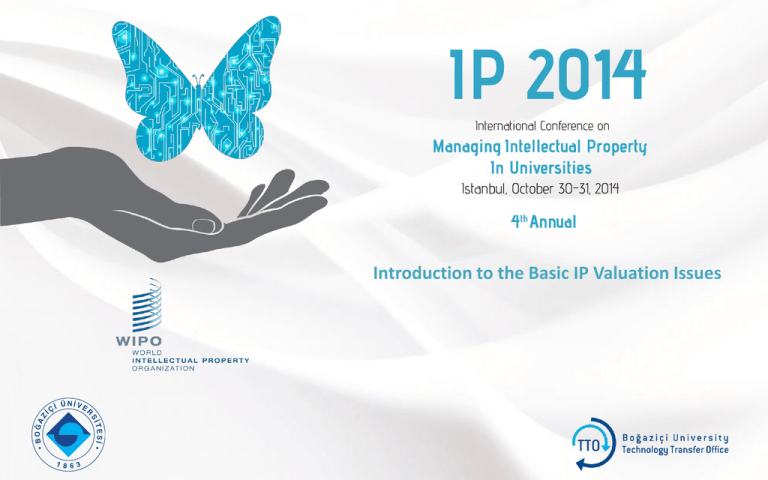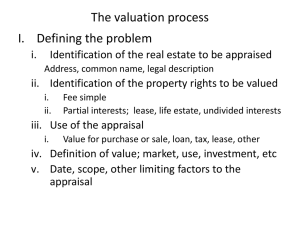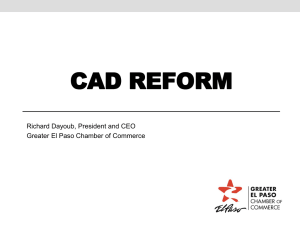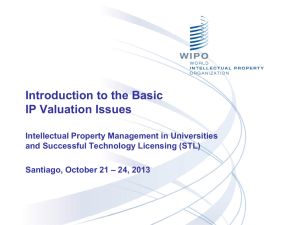IP Valuation Methods and Approaches Income Method
advertisement

Introduction to the Basic IP Valuation Issues Topics • • • • • What is IP Valuation ? Intangibles – Subject Matter of TT Agreements Qualitative and Quantitative Valuation Basic IP Valuation Methods and Approaches Conclusions What is IP Valuation ? • Valuation: The process of identifying and measuring benefit and risk from an intangible asset. Benefit Risk Intangibles Subject Matter of TT Agreements • Intangible assets – non-monetary assets. • “Legal Intangibles” – Intellectual property (IP) refers to creations of the mind: inventions, literary and artistic works, symbols, names, images and designs used in commerce. Once protected under the relevant IP laws – IP becomes legally enforceable right. – Patents – Trademarks – Brands – Industrial Design – Copyright – Trade Secrets / Know-How etc. • • IP is not an asset by itself – only when strategically managed by skilled professionals. Number of patents or other protected IP is not an indicator of innovative effectiveness of the organization, the most important is IPR management and results achieved – added value. • “Competitive Intangibles” – impact competitiveness, efficiency, reduce costs, increase revenues, etc • • • • • • • Human capital – primary source of competitive intangibles Collaboration activities Organizational processes Know-How Business Plan List of partner institutions Reputation. When is IP Valuation Used ? • Litigation • • • • • • • IP audit (management tool) Licensing Joint ventures (collaborations) Merger and acquisition Financial reporting Financing Investment transactions IP Valuation in R&D Environment • • • • • • • Tool in a decision making process – provides management with useful information as a base for decisions in pre commercial and commercialization phase; Important part of the technology transfer processes – collaborations, sponsorships, licensing, establishing of the start – ups, etc; Enables fund raising; Communication tool – about the value of technologies developed by R&D, and products based on them; Supports learning process – how to add value to the organizational processes, human capital, research results, IP etc; Monitoring on return on investment; Litigation – rare situation for publically funded research institutions. Intangibles Subject Matter of TT Agreements • Technology transfer agreements have as a subject matter Intangible Assets – in particular intellectual property; • Licensing Agreement – IP is an exclusive subject matter; • Collaboration Agreement; • Sponsored Research Agreement; • Material Transfer Agreement; • Consultancy Agreement; • Confidentiality Agreement; • Research Service Agreement, etc. Intangibles What is so Different than Valuating Tangibles? • Valuation – The process of identifying and measuring financial benefit of an asset. • Valuation of Intangibles – The process of identifying and measuring financial benefit and risk of an asset, in a particular context. • Risk • Time – What is the time needed to bring technology on the market? Sometimes even breakthrough technology can be « too early » for the market. • Money – How much more do we need to invest? • Risk is a particularly important element in the valuation of early stage technologies – more time and money needed to bring technology on the market – less value. Risk and Money? Closer to the market, with and without financial partner – the value of IP will be different for the same asset. « Background » Research Result 1 P Development 10 30 P Commercialization 50 Intangibles What is so Different than Valuating Tangibles? • The price is not the value of an intangible asset, while the price of a tangible asset is usually the expression of the real value. • The price is what is proposed to the other side of the deal and it depends on how « thirsty » is the other side for that particular technology. • The value of an intangible is the financial benefit that an asset can generate in a particular context, taking fully into account the risk that the investment in the development of the asset may be higher than realized value. • The potential value of intangibles depends on the context in which that value will be realized. Intangibles What is so Different than Valuating Tangibles? • • • Most intangibles are capable to generate more than one value stream simultaneously. In certain contexts the value is determinate by the authority, relevant laws (tax laws) or empirical experiences. It is important to define approach to value: – Understand actual value of an asset in use for actor, – Potential value in use, – Value construction – for negotiation purposes. Negotiation value Fair value Owner value Collateral value Market value Asset Investment Value Synergy value Emotional value Communication Qualitative and Quantitative Valuation • • • • IP valuation is both qualitative and quantitative in nature, as calculations are always based on qualitative analysis. Qualitative methods provide a value guide through the rating and scoring of IP based on factors which can influence its value. It examines, at a micro level: – the quality of intangible assets themselves; – their position and importance, relative to other business drivers; – the broader industry within which the business operates; – the potential value for business’s competitors and potential competitors. The macro-economic outlook, over the useful life of the intangibles, for the economy in which the business operates. Qualitative Valuation • The qualitative study is used to formulate (and justify) assumptions on which the financial models, used to determine a numerical value to the IP under consideration, will be based. – Rating & Scoring – Components • (1) Scoring criteria • (2) Scoring system • (3) Scoring scale • (4) Valuing factors, and • (5) Decision rules. Elements to be Taken into Consideration • Technical Characteristics – Innovative, inventive, “new”; – Technology Development – Complementary Assets • Market Relevance – Market Potential – Market Maturity – Competitors IP – Legal Protectability – Freedom of Operation Financial • • • Subjective Factor - Team – Competence and Openness for Collaboration Examples of Scoring Criteria • Internally developed ranking criteria, such as “8 leading factors”: – Suitability for Suggested Application – Cost – Development Status – Exploitation Rights – Degree of Novelty – Marketing Interest of Partner – Quality of Technology Information – Sociability of Technology Provider • Or – – – – – – – Patentability Patent Strength Status of Invention Market Situation Inventor’s History – Supportive or not in the process of transfer? Additional Services for the Partner ( potential for continuation of collaboration) To whom shall invention be licensed Elements of Ranking – IP Valuation, Wroclaw 2013, Team I Each element has fixed weight, from 0,6 to 1,4 Element Weight Ease of collection 1 Market potential 1,4 Barriers of entry 1,2 Technology development 0,8 Competitors 1,2 Legal protectability 1,2 Relative technical experience 1,2 Communication skills of researches 1 Experience with business and industry 1 Interdisciplinary potential of technology 0,8 Qualitative and Quantitative Valuation • Quantitative methods attempt to calculate the monetary value of the IP and include: – Cost – Market – Income – “Rule of Thumb” – Monte Carlo – Industrial Standard – Real Option – Other Methods. IP Valuation Methods and Approaches • Cost Method • Cost-based models approximate IP value by determining the replacement/creation around cost of equivalent IP. • The approach, while useful in the situation where there is no other available data – wholly disregards the innovation and uniqueness of the IP. • There is no “equivalent” or “identical” IP – that negates the novelty and inventiveness – that define intangible assets. • Intangible assets tend to grow over time, use and investment so their full value is not apparent at inception – that is why it is so difficult to project a real commercial value of early stage technology. IP Valuation Methods and Approaches • Cost Method • Correlation between the cost and value may arguably be used: – at the pre-commercialization outset of the IP; – as a starting point for licensor (R&D institution) in constructing a negotiation value of the IP – licensor would like to cover the costs of development of technology and protection of the IP; – helps to understand the position of the other negotiation party. IP Valuation Methods and Approaches • • • This method is more appropriate for tangible assets – where cost reflects the value of the asset. Disadvantages of the Cost Method: – Limited effect; – Does not show earning power of the technology and ultimate market share; – Cost to “create around” – not an indicator of the value of an asset as with the time needed the technology may become obsolete; – “Creating around” – there is a potential danger of an infringement of the model technology; – Cost of development – totally wasted or dramatically understated value of the product or service. In TT negotiation “cost of the development” of technology is rarely accepted as an argument – “I do not want to pay for an inefficient licensor!” IP Valuation Methods and Approaches • Market Approach • • • • • • • Postulates intellectual property value as the amount for which equivalent IP was either sold or offered for sale on the open market. Two Steps Process: – – Identification of the similar transaction; Adjustment to the current case and specific context. As the cost approach, there is an assumption of the existence of intangible assets that are sufficiently equivalent to those being valued. Does not take into account that in the contractual context the IP is valued in correlation with other key terms of the agreement – exclusivity, territorial aspects, duration, available knowhow, post contractual services, etc. The approach also suffers from the scarcity of available information – IP market is still not sufficiently developed. If a sale price / royalty rate is made public, the amount allocated to IP from the total purchase price is not reported or other terms of contract are unknown. Useful: – For tempering future-income-based forecasts; – For valuation of early stage technology – as a starting point in income based valuation, if there is no other indicators for determining the price of the future product containing new technology. IP Valuation Methods and Approaches • Disadvantages of the Market Approach : – Difficult to find similar transactions; – If used following comparability factors should be identified: • Relevant time period – the future is a focal point! Expected cash flow – not price paid! • Financial situation of the parties – are both parties on equal footing? • Relevant industry transactions – similar technology in a similar industry sector – each industry has a set of unique economic forces: – Consumer electronics – highly competitive; – Airlines – oligopolies; • Foreign transactions – relevant only in the countries with similar economic development and legal framework; • What are complementary asset investment requirements – high infrastructure pre investment will diminish the value of IP; • Non-monetary compensation – “grant backs”, “technology share”; • Independent status of the parties – negotiations are different if parties are in alliances and joint ventures (Merck & Co – Johnson & Johnson). IP Valuation Methods and Approaches • Income Method: Projection of the future revenues that the IP asset can be expected to generate on the market over a certain period of time taking into account the time, value of the money and the risk that the income will not be realized. • • • • Essential Elements of the Projection – Market Penetration – Sales Forecast (sales growth) • Conditions of the general economy; • Developments in the industry in which product will be produced; • Conditions that will influence customers; • Competitors reaction. – Time – Changing Value of Money (over the time) – Risk Pre-commercialization costs – should be also taken into consideration. Production Costs – difficult to predict for an early stage technology, previous experience with similar technology can be an useful foundation. Overhead costs – historical experiences – – – – – Advertising; Education about the new product; Promotion of product on fairs; Discount promotional fees; Development of related intangible assets (know-how, services, training etc.). IP Valuation Methods and Approaches • Different Approaches of Income Method – Discounted Cash Flow – – – – Monte Carlo Real Option Royalty Revenues “Rule of Thumb” – 25% Rule Income Method Discounted Cash Flow Approach (DCF) • DCF is the most frequently used approach of the Income Method; • A projection of a future net cash flow expected from the commercial use of an intangible asset under review; • Over a period of the economic life of the IP; • “Discounted” by the time value of the money and risk (“discounted rate”); • Objective: determination of the Net Present Value of the IP asset. How DCF Calculation Works (continued) n PV = Σ t=1 CF(t) t (1+r) How DCF Works Basic Elements • • • • • Potential Market Growth of the Market in the Future Time under Review – Economic Life of an Asset Penetration Rate of the New Technology Expected Cash Flow from the Exploitation of the New Technology • Determination of the Net Cash Flow – as a base for discounting and calculation of the Net Present Value • Discounting Rate • NPV – Sum of calculated discounted Net Cash Flow for each year under review ! Exercise :“Smart Turbine” • Combination of “wind-solar” turbine technology was developed by the university and licensed to a big, well known multinational company; • It was envisaged that the product will be ready for selling in 2013; • Potential cash flow on 10 top markets for renewable energy was estimated on about 10,5 billion Euros in 2013, with the forecasted growth of 16% per year; • Period under review – 6 years; • Penetration rate – 10% of the potential market cash flow in the first year, 30% in the second, 60% in the two following years. Valuator estimated that the sales of the technology will decline in the last years under the review and that the “curve” of penetration will move towards 50% and than 40% of the market share; • Discount (risk) rate was determinate to be 8% . Period of the review (year) 2013 Expected economic growth of total new turbine market (16%) 10.5 BE Market penetration rate for Smart Turbine tech. 10% Projected cash flow for Smart Turbine tech (in the frame of the penetration rate) Net Cash Flow(10%) 2014 2015 30% 60% 2016 2017 2018 Discount factor Discounted value of 1 Euro Discounted Cash Flow Net Present Value 1 (1.08) .926 1 _ (1.08)2 .857 1 _ (1.08)3 .794 1 _ (1.08)4 .735 1 (1.08)5 .681 1 (1.08)6 .630 DCF – Early Stage Technologies Early Stage Technology – high risk – as there is a delayed time to income and additional investment needed. – – – – High discount rate counterbalances high risk; Delayed income and high discount rate – lower the value of technology; Technology risk very high; Commercial risk very high: • Inflation • Competition • Changing economic climate. – Expected returns and “paydays” should be proportional to the risk and stage of technology development : – Start up (protected idea) – 50% – First stage (prototype) – 40% – Second stage – 30% – First stage – 25% DCF – Early Stage Technologies • • Discount rate reflects risk, usually similar in the same industry sector. Biotechnology and pharmaceutical industry – early stage technology particularly risky. • Professional estimations: » Discovery – 80 % » Preclinical – 60% » Phase I Clinical trials – 50% » Phase II Clinical trials – 40% » Phase III Clinical trials – 25% » New drug application – 22,5% » Product launch – 15%-17,5 % • • Venture capitalists – short term investors – 5 to 7 years to get out of investment. Often VC for an investment in an early stage technology would consider 50% as a reasonable discount rate – and would like to realize proportional return on investment. DCF Approach in the Context of Licensing “Over the useful life of the intellectual property, what would I save by owning, rather than licensing, the intellectual property under consideration?” • • Projection of the future royalty stream (instead of “net cash flow”), discounted for the risk and money value over the time. In practice it is a “constructed value” between negotiation parties taking into account: – Business objectives and strategies of both parties; – Other Key Terms: • Quality of the subject matter (IP) of the licensing agreement: • • • Technical Legal Market • Scope of the rights • • • • • Exclusive / non exclusive Field of use Territory Time Sublicensing rights • • Financial terms Non – Monetary benefits – “grant – backs”, services • “Hunger” of the other party Monte Carlo • Monte Carlo Simulation – computer based sophisticated version of the multiple scenario DCF. • For each DCF element it provides a range of possible values and different options for the distribution of these values. • It provides projection of thousands scenarios and net present values, in a form of a frequency chart – easy to visualize the probabilities of net present outcomes. Monte Carlo Industrial Standard • • • • • Standard Industrial Royalties Some industries have developed standard royalty rates over the years based on what could be considered “rules of thumb”. Inconvenient for IP – patents and other IP aren’t commodities and thus can not be accurately valued at a set rate. However, if a patent is being valued for an external transaction within an industry that traditionally applies standard royalty rates, then the use of this standard rate in the valuation can not be totally dismissed. For an internal valuation, the use of standard royalty rates is not recommended. “Les Nouvelles” LESI Journal (September 2010) “Rule of Thumb” • Licensor, as developer of the technology, considers as a fair deal to get 25% - 33% of the licensee’s profit (not income). • Different opinions about the value of the method. • In practice often used as an indicator. • Recently formally forbidden in US litigation. Conclusions • IP Valuation is an ESTIMATION of an intangible asset value, thus it is not a precise figure. • It is always qualitative and quantitative, and potentially subjective (having access to more or less same data, two valuators can always come out with different figures). • Experience is essential! • In contractual relations it is important to develop “starting point” for negotiation – even if there is a reasonable difference in the projection of the value, it is an advantage to be able to show reasoning behind the “value structure”. Thank you! Olga Spasic Head, Innovation Structures Section Innovation Division olga.spasic@wipo.int






